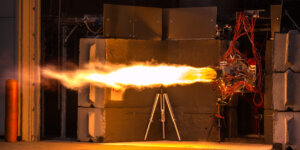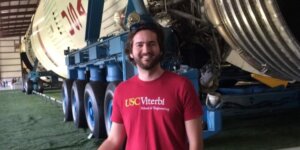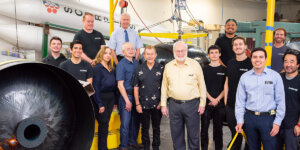At 110 feet, it was one of the largest 3D printed metal objects on Earth.
Last night, after a fiery launch from Cape Canaveral, it was a blue-white streak in the Florida sky.
In a significant milestone for the future of space exploration, Terran 1 became the world’s first 3D printed rocket to achieve launch. It was the culmination of a 12 year journey between alumni Tim Ellis (B.S. ’12, M.S. ’13) and Jordan Noone (B.S. ’14), the former leaders of the USC Rocket Propulsion Laboratory (RPL) who co-founded Relativity Space, now valued at $4.2 billion, in 2015.
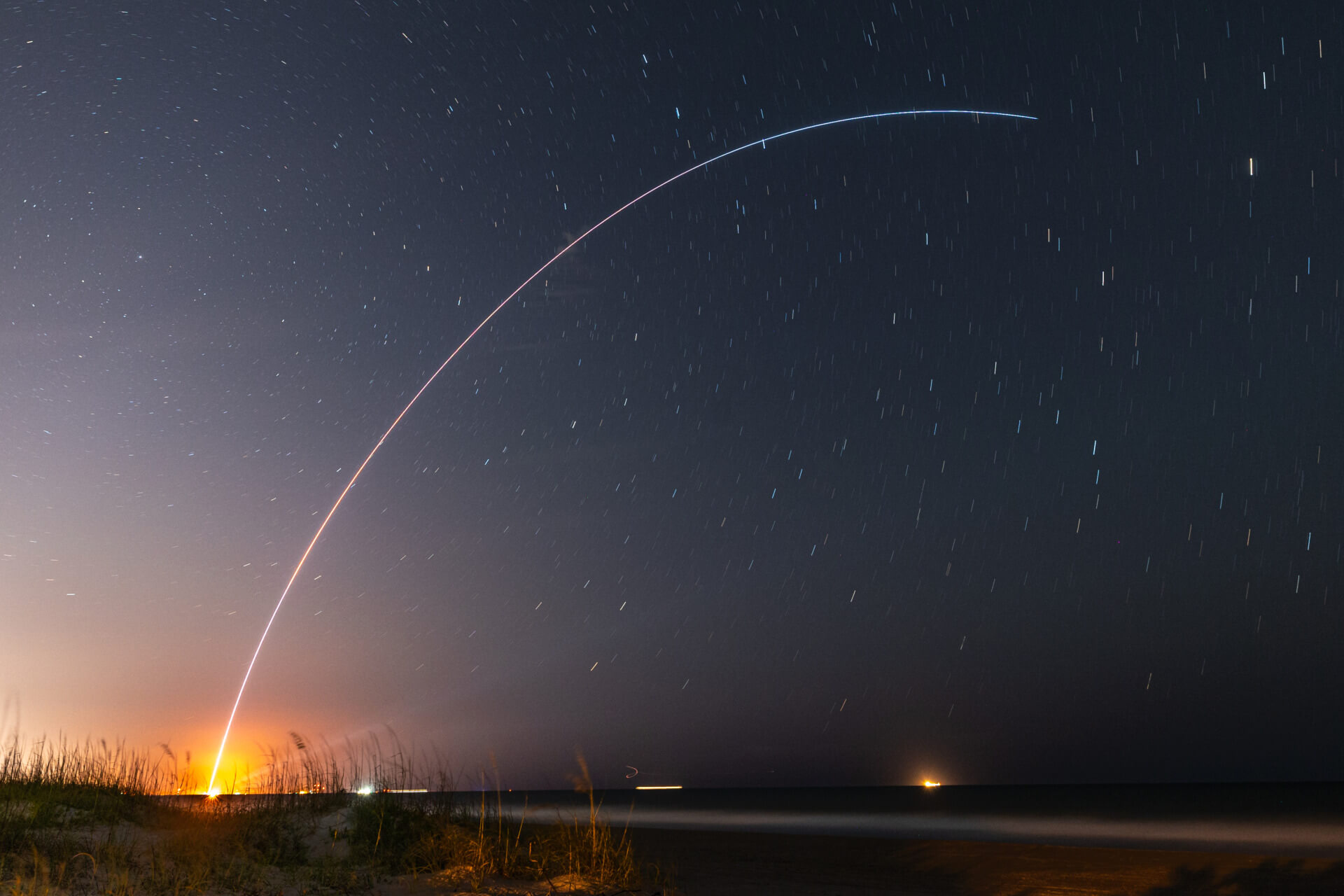
The methane fueled rocket, Terran 1, goes supersonic in the Florida night sky. Photos: Trevor Mahlmann/Relativity Space.
The Terran 1 rocket — 85 percent 3D printed — augurs huge changes to the space industry in terms of cost, speed, less waste and greater design efficiency.
Though the launch, dubbed “Good Luck, Have Fun,” was unable to reach space in its first attempt — something no private space company has been able to achieve — it scored a number of firsts.
According to the company: “Today’s launch proved Relativity’s 3D-printed rocket technologies that will enable our next vehicle, Terran R. We successfully made it through Max-Q, the highest stress state on our printed structures. This is the biggest proof point for our novel additive manufacturing approach. Today is a huge win, with many historic firsts. We also progressed through main engine cutoff and stage separation. We will assess flight data and provide public updates over the coming days.”

A glimpse of Terran 1’s nine, 3D printed Aeon engines during the ascent.
Said Noone: “Relativity’s 3D printing approach with Terran 1, the world’s first 3D printed rocket, draws forward aerospace manufacturing into the digital era. This launch opens the door for all the potential future applications of that development, such as human space flight.”
According to Ellis, Relativity’s CEO, while traditional rockets use hundreds of thousands or even millions of parts, Relativity uses less than a thousand. The company, whose goal is to 3D print 95% of their future rockets, uses their giant Stargate 3D printers to produce the engines as well as the primary structure of Terran 1. Like a futuristic Model T assembly line crossed, the company hopes to create a rocket from raw materials every 60 days.
In order for this to become a reality, Ellis and Noone had to not only build a rocket, they had to reinvent advanced manufacturing.
“We had to invent the actual process itself,” said Noone, who left his role as Relativity CTO in 2020, but remains an executive advisor. “It was kind of like building a 3D printing company and building a rocket company at the same time under one roof – each a very complex thing to do! That was the big bet: could we do both at the same time?”
In order to 3-D print rockets, they first had to create the Stargate, the world’s largest metal 3D printers. The fourth generation Stargate printers — named after a 26th Century technology in the video game “StarCraft” — defy traditional printing constraints by moving horizontally rather than vertically.
For Ellis, even as Relativity builds more rockets, he hopes to one day 3D print all the machinery that would sustain the first Martian colonists, including “the first rocket made on Mars.”
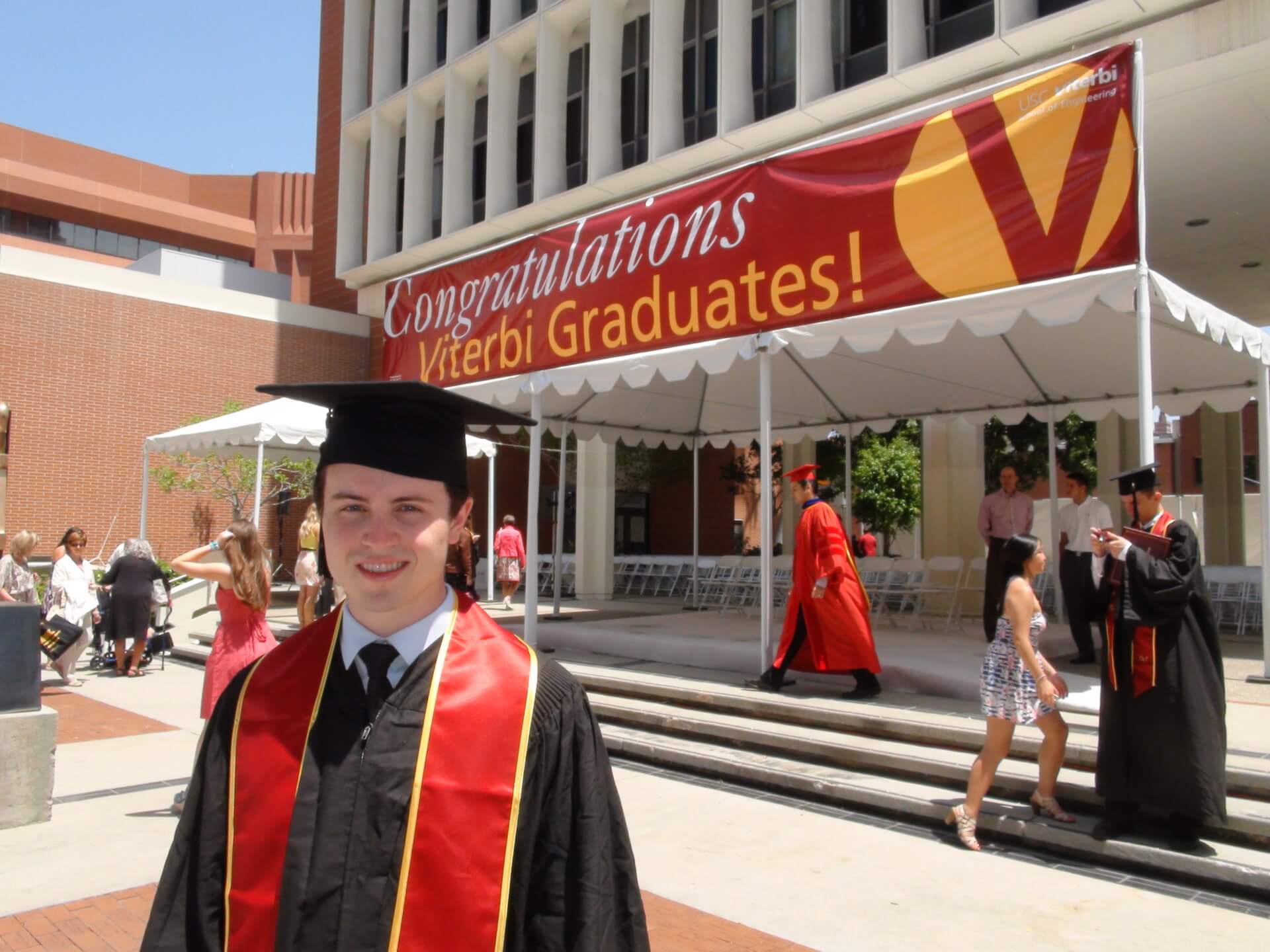
Tim Ellis, co-founder and CEO of Relativity Space, seen here on USC graduation day, was named to MIT Technology Review’s list of “35 Innovators Under 35” in 2019.
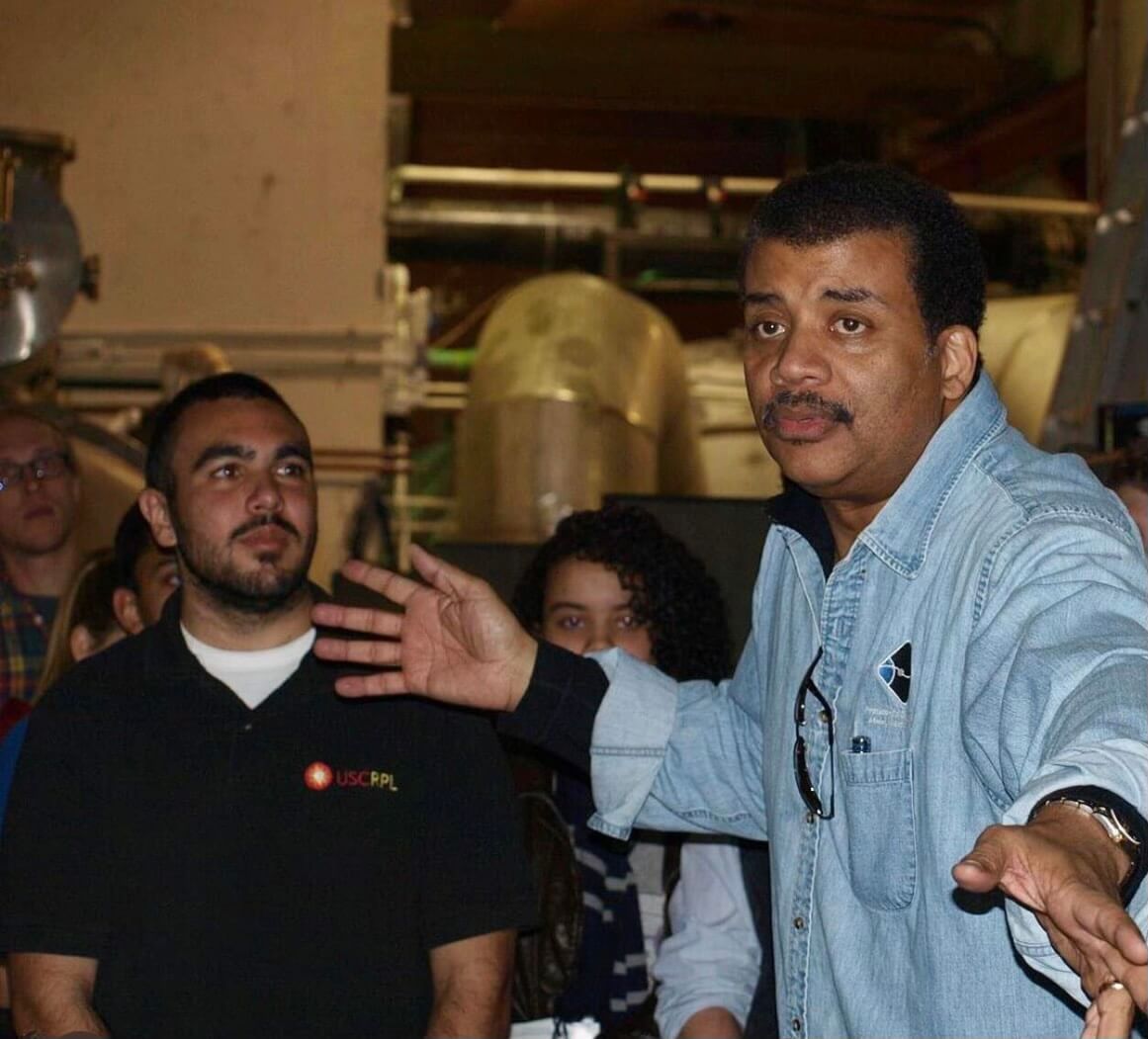
Jordan Noone (left), seen here during a visit by Neil deGrasse Tyson to the USC Rocket Propulsion Laboratory in 2013, became the first student in the world to obtain a FAA launch license to fly a rocket to space. The Relativity co-founder and former CTO is now general partner in Embedded Ventures, investing in a portfolio of space-related startups.
The duo first met in 2010 as students at the USC Viterbi School of Engineering.
Ellis, who was then a USC Viterbi junior, recalls his first meeting with Noone: “I still remember he joined USC’s Rocket Propulsion Lab, and I think he wasn’t even 18 yet and said he was going to run the whole lab. I just thought that level of cockiness and ambition was sort of rare, but he had the talent to back it up! What he promised, he delivered on. USC Rocket Propulsion Lab went on to become the first student group in the world to launch a rocket to space.”
That 2019 launch — the world first’s successful student built and designed rocket to reach outer space — was but a foretaste of what was to come.
Said Yannis Yortsos, dean of the USC Viterbi School: “Jordan and Tim represent the very best of USC: visionary, entrepreneurial and creative. Last night’s launch is merely the fulfillment of the incredible promise they showed as student leaders.”
After graduation, they would talk on the phone during their commutes to and from work. Noone remembers driving home in his Volkswagen Jetta, sometimes calling Ellis at 2 a.m. He’d be getting off work at SpaceX in Hawthorne, while Ellis would be leaving his job at Blue Origin — Jeff Bezos’ space company — in Kent, Washington.
Both their companies had “lukewarm interest” in 3D printing technology. While many companies used 3D printing for some elements of their rockets, nobody was thinking about it quite on the scale of Ellis and Noone.
At SpaceX, Noone recalls, the rule companywide was “no science projects.”
“And 3D printing development was, admittedly a science project,” said Noone. “We’re talking non trivial, very foundational, scientific physics level development of the printing process.”
And so, after a cold email to investor Marc Cuban (subject line: “space is sexy, 3D printing an entire rocket”) netted a half a million dollar commitment, Ellis and Noone were ready for their science project.
One of the early relics in Relativity lore was on the back of a Starbucks napkin — then a popular hangout for the two admitted “caffeine addicts” — where they sketched out their initial vision of a Martian voyage, powered by 3D printed rockets.
Said Ellis: “I always thought (Noone) was a good foil to me. He was more of a pessimist and a realist and kind of a stickler for details, and that was very helpful in formulating our early ideas. We balanced each other.”
That balance eventually led to the birth of a SpaceX rival, one that has already pre-sold an enviable $1.65 billion in space launches.
Now, with this successful launch, Ellis may soon move forward with Terran R, a fully reusable, medium to heavy 3-D printed rocket.
In July 2022, Relativity announced their first commercial mission to Mars in partnership with Impulse Space. With an anticipated launch window in 2024, the historic partnership advances both companies’ shared goal of a multiplanetary existence for humanity. Relativity’s role: to launch Impulse’s Mars Cruise Vehicle and Mars Lander in Terran R from Cape Canaveral, FL.
For Noone, he’s looking to build an entire portfolio of space-related companies.
As general partner of Embedded Ventures, one of about a dozen venture capital firms looking to invest in the next “space unicorn,” Noone is joined by Jenna Bryant, co-founder and general partner and CEO, in identifying new startups in the realm of “national security space technology.”
Last month, Embedded launched its inaugural $100 million fund, and they’re now deploying capital. In 2021, they signed a first of its kind cooperative agreement with the U.S. Space Force to spotlight dual use space startups that could serve both commercial and defense customers.
Noone and Bryant are also investing heavily in the next generation of talent.
Concerned by the disparity of women in aerospace — as of 2021, just 12.5% of all aerospace engineers in the United States were women — Bryant and Noone approached the USC Viterbi School. The result? A generous 2022 gift from the two, resulting in the rebirth of Project Payload, a USC Viterbi summer program offering middle school girls a hands-on, problem-based learning experience in the fields of aerospace engineering and computer science. The program culminated with the launch of a high-altitude balloon at STARBASE in Los Alamitos.
Recently, NASA announced a return to the moon with its Artemis (sister of Apollo) missions as early as 2025. The inaugural missions will land the first woman and person of color on the moon. Artemis will also establish the first long-term presence on the moon.
Eventually, NASA, like Relativity, seeks a human voyage to Mars.
And if Noone and Bryant have their way, these young women from Project Payload, only 6th to 8th graders now, may be among the first crew and explorers to the Red Planet.
Published on March 23rd, 2023
Last updated on March 23rd, 2023




